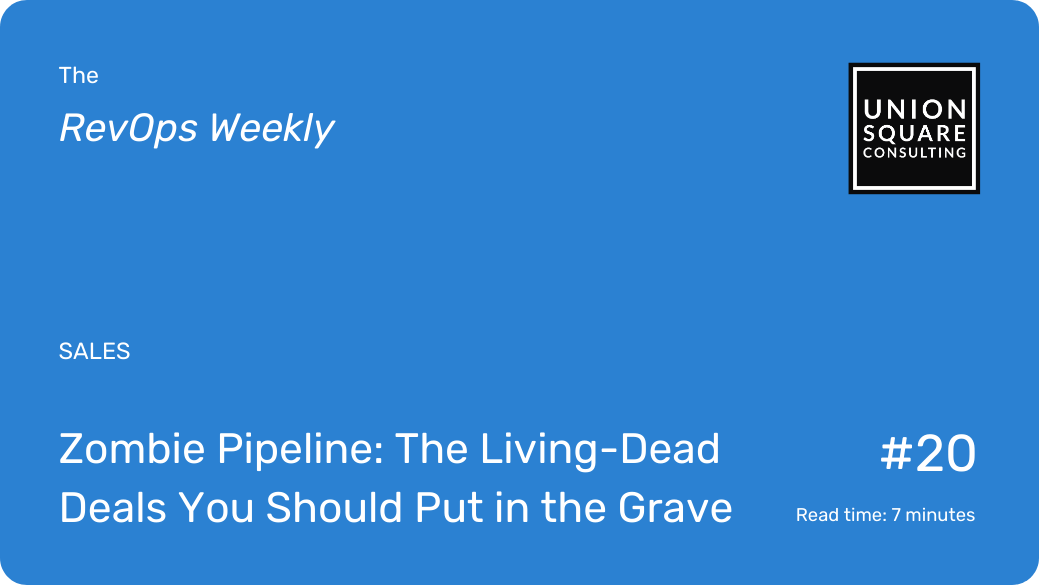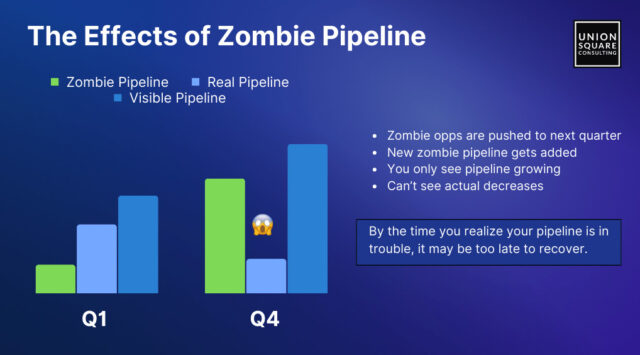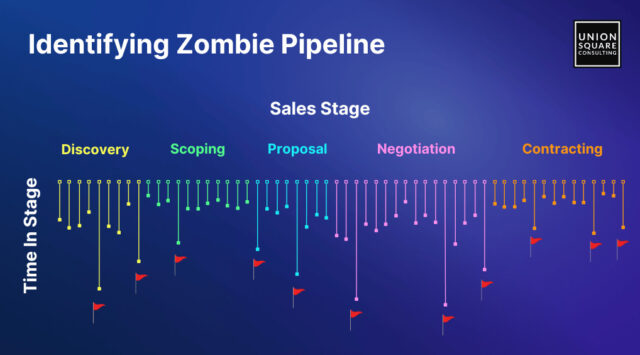
Zombie Pipeline: The Living-Dead Deals You Should Put in the Grave
Read time: 7 minutes“No, wait! There’s still time – I can close them!” The salesperson begs, but it’s no use. I can see the signs. Those opportunities are long gone.
“You’ll never sell a thing to them,” I say, moving the opportunities to Closed Lost. “This needs to end right here, right now.”
“NOOOO!”
*Click. Click. Click…*
And just like that, $9 Million out of an $18 Million pipeline is put down for good.
This is a true story. Well, maybe it wasn’t that dramatic. But closing out half of my company’s pipeline in one day definitely felt that way.
So why did I do it?
How did I spot the infection?
And what happened next?
Why Zombie Pipeline is a Business Killer
What happens when a sales team never closes lost opportunities?
The opps become undead, growing in number, always being pushed out to next quarter, and artificially inflating your pipeline.

On the outside, everything looks great.
Then at some point (when it’s too late to do anything about it), you realize that you’re going to miss your numbers for this quarter. And the next. And likely the one after that.
You start fighting with your salespeople to go after that horde of opps.
Your salespeople spend weeks trying to close these zombie opportunities. They don’t. “The timing just isn’t right, but they’re going to close next month. I’m sure of it!”
Since you’ve been relying on a false positive indicator that everything was going great, all types of data from every stage of the funnel is completely skewed.

Without being able to trust your data, you can’t lead your organization.
If you’re a sales leader, more than likely, you’re fired within the year.
But this spooky story can have a happy ending – by saving your business from the zombie pipeline apocalypse.
How to Identify Zombie Pipeline
The biggest indicator of zombie pipeline is the length of time they stay in a stage. Since these prospects keep ghosting your salespeople, they never progress.
To pinpoint the walking dead, all you have to do is:
- Determine the typical amount of time that normal opps spend in each stage
- Identify the opps that have been in their current stage for 2x that time (or longer)
- Make a list of these opps and start asking questions. Have they stalled out?

Here are some common red flags to watch out for:
- Opps with outdated Next Steps
- Opportunity age 2x the normal sales cycle
- Time in Stage is 2x the normal stage cycle
- Late stage opps with no approved budget
- Late stage opps with no Joint Evaluation Plan
- Opps set to close very soon with no recent activity
- Late stage opps with no access to decision makers
Close these opps out of your pipeline, even if you still want to follow up with them later.
(Opportunities are often used as placeholders for follow-up, even if the deal isn’t really in motion. Don’t do that!)
Closing Out Zombie Pipeline 😨😨
It can be scary to close out a lot of pipeline at once, especially if you have a particularly bad infestation.
Be prepared to:
- Suddenly have more Closed Lost deals
- With the same Closed Won deals
- So your Close Rate plummets
Because of this, communication ahead of time is a must. Your organization should be aware there’s a problem, that a reset is needed, and that there will be an impact on the metrics.
The reality is that these deals are already dead.
Any win rate you’re showing now is wrong, and this reset will make it accurate (maybe for the first time). Without the reset, you’ll simply never be aware of your real win rate until it’s too late to save.
It’s better to start again at square one than to run the business into the ground, kicking the can down the road.
If you can, it’s always better to prevent Zombie Pipeline in the first place.
How to Prevent Zombie Pipeline
Zombie pipeline is never created maliciously. It happens accidentally, every time.
If you judge a salesperson’s performance on maintaining a certain level of pipeline, they will maintain that pipeline whether it’s good or not.
There’s only one way to prevent zombie pipeline: Make it OK to lose an opportunity.
You can do this by:
- Creating clear processes for when to close a lost opportunity
- Measuring and incentivizing performance by deals won, not pipeline created
- Making it safe for your people to close opportunities out and not get dinged for it
Start embedding these practices into your sales culture now. It’ll save you plenty of headaches in the future.
But there’s still something else that needs your attention, that very few companies do…
The Struggle of Keeping a Clean Pipeline
Even with these prevention measures in place, zombie pipeline can slip through the cracks.
Which is why you need to run regular pipeline reviews.
This is easy in smaller organizations where the leader knows every deal well enough to catch the BS. But when senior leadership is no longer involved in every deal, the BS stops getting called out. At most, the reps update the data on the “Next Step” field and leave it at that.
#kickthecan.
To make matters worse, managers often refuse to pressure their team to close out any pipeline. (Usually because they have the same incentives as the reps to keep zombies around – which is why proper incentive plans should always be your first step!)
Senior leaders need to look at the data and drive the real tough conversations with reps.
To do this right, you’ll want to go through your pipeline regularly, deal by deal, inspecting them for the red flags listed above.
You can make this easier by identifying key fields to track in Salesforce (or your CRM of choice), running a report, and reviewing that report regularly.
The tricky part here is choosing what information to select – being careful not to ask too much of your salespeople – and consistently training your team to populate this data.
For example, say you have a Stage 2 opportunity (out of a 7 Stage sales pipeline). It’s marked to close on October 31st, today is October 24th, and your next steps are:
“10/15 – Follow up with Mike”
You have a week to take this deal from Stage 2 to Stage 7, and your “next steps” are already nine days overdue. This is a red flag. You’ll need to investigate this deal more and figure out why it has stalled.
After enough repetitions of going deal by deal, asking your reps to update their data, and asking questions around what you see, your salespeople will commit this to muscle memory. Keeping on top of it will be much easier and you’ll have a consistently cleaner pipeline.
Can this be annoying? Sure. Time consuming? Definitely.
But it’s what great sales leaders do. And it’ll help save you from a much more painful zombie clean-up later on.
TL;DR
- Zombie pipeline blinds you from what’s actually happening in your business with an artificially high win rate and unusable data
- You won’t know the ship is sinking until it’s too late
- Weed out zombie pipeline by identifying opps that are spending twice as long in a stage than normal
- Prevent zombie pipeline by making it easy and risk-free for salespeople to close out opportunities that aren’t going anywhere
When you’re ready, here’s how we can help:
Get a Free 1:1 Revenue Efficiency Workshop
Get one of our Senior Revenue Strategists to yourself for 1 hour and leave with a plan to increase the money-making power of your go-to-market operations.
Hire Us!
Bring us on as your Strategic RevOps Team and realize the growth potential of your revenue engine. There are 3 ways to work with us.
Get more tips like these, sent right to your inbox.
Subscribe for fresh, relevant revenue growth tips delivered every week.